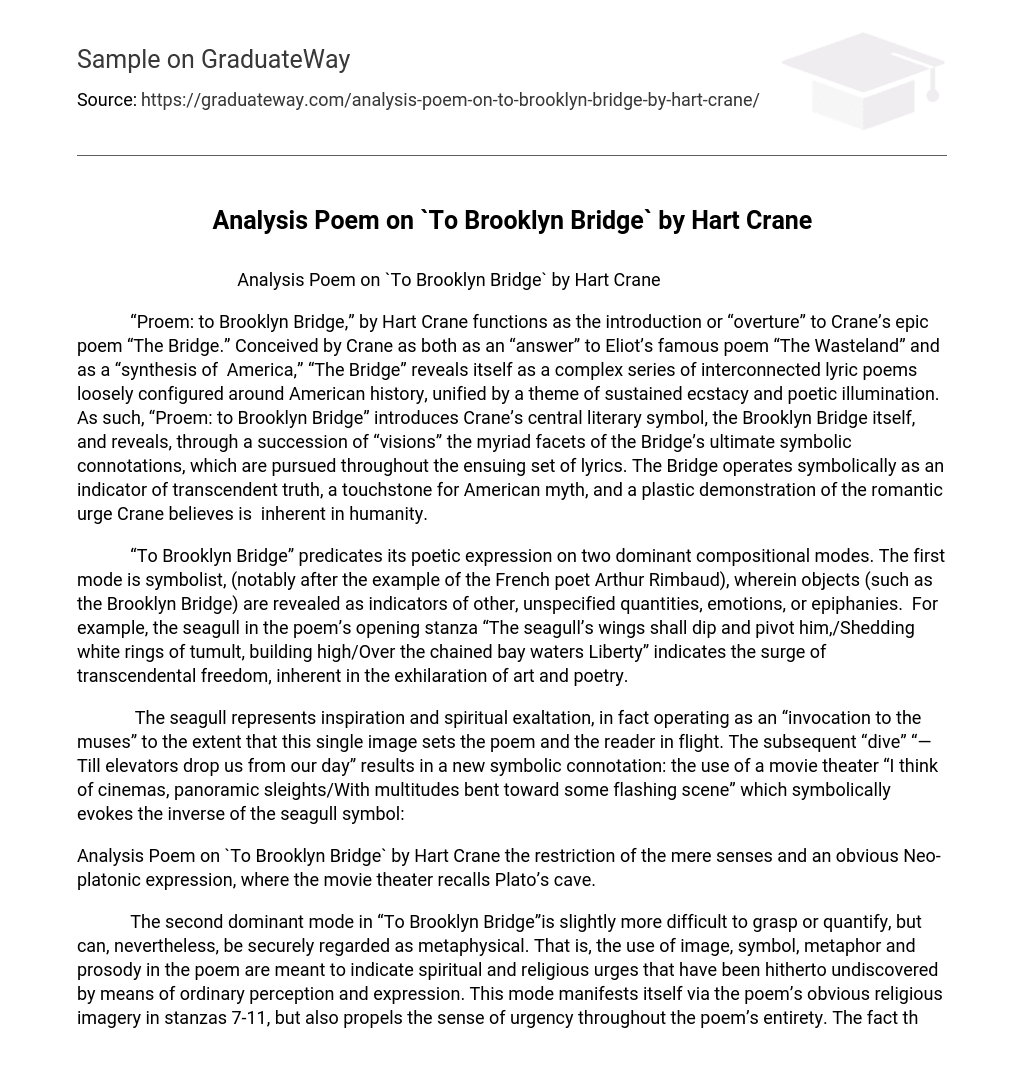“Proem: to Brooklyn Bridge,” by Hart Crane functions as the introduction or “overture” to Crane’s epic poem “The Bridge.” Conceived by Crane as both as an “answer” to Eliot’s famous poem “The Wasteland” and as a “synthesis of America,” “The Bridge” reveals itself as a complex series of interconnected lyric poems loosely configured around American history, unified by a theme of sustained ecstacy and poetic illumination. As such, “Proem: to Brooklyn Bridge” introduces Crane’s central literary symbol, the Brooklyn Bridge itself, and reveals, through a succession of “visions” the myriad facets of the Bridge’s ultimate symbolic connotations, which are pursued throughout the ensuing set of lyrics. The Bridge operates symbolically as an indicator of transcendent truth, a touchstone for American myth, and a plastic demonstration of the romantic urge Crane believes is inherent in humanity.
“To Brooklyn Bridge” predicates its poetic expression on two dominant compositional modes. The first mode is symbolist, (notably after the example of the French poet Arthur Rimbaud), wherein objects (such as the Brooklyn Bridge) are revealed as indicators of other, unspecified quantities, emotions, or epiphanies. For example, the seagull in the poem’s opening stanza “The seagull’s wings shall dip and pivot him,/Shedding white rings of tumult, building high/Over the chained bay waters Liberty” indicates the surge of transcendental freedom, inherent in the exhilaration of art and poetry.
The seagull represents inspiration and spiritual exaltation, in fact operating as an “invocation to the muses” to the extent that this single image sets the poem and the reader in flight. The subsequent “dive” “—Till elevators drop us from our day” results in a new symbolic connotation: the use of a movie theater “I think of cinemas, panoramic sleights/With multitudes bent toward some flashing scene” which symbolically evokes the inverse of the seagull symbol:
Analysis Poem on `To Brooklyn Bridge` by Hart Crane the restriction of the mere senses and an obvious Neo-platonic expression, where the movie theater recalls Plato’s cave.
The second dominant mode in “To Brooklyn Bridge”is slightly more difficult to grasp or quantify, but can, nevertheless, be securely regarded as metaphysical. That is, the use of image, symbol, metaphor and prosody in the poem are meant to indicate spiritual and religious urges that have been hitherto undiscovered by means of ordinary perception and expression. This mode manifests itself via the poem’s obvious religious imagery in stanzas 7-11, but also propels the sense of urgency throughout the poem’s entirety. The fact that “To Brooklyn Bridge” meets the printed page, italicized throughout, also promotes the motion and urgency of an invocation or prayer.
Prosodically, ‘To Brooklyn Bridge” presents eleven blank-verse quatrains. This form fosters a formal, deliberate atmosphere while avoiding the predictability of a regular rhyme-scheme or the “digressive”feeling of free-verse. Against this prosodic form, Crane poses brilliant variations in meter: “A bedlamite speeds to thy parapets,” “A rip-tooth of the sky’s acetylene,” as well as compressed diction: “Of anonymity time cannot raise;” “Unfractioned idiom, immaculate sigh of stars,” and stunning imagery; “Under thy shadows by the piers I waited;/Only in darkness is thy shadow clear.”
Crane’s diction owes considerable debt to his own conception of the “logic of metaphor” wherein a type of metaphorical and linguistic “shorthand” aspires to replace expository or non-metaphorical language in poetry. “To Brooklyn Bridge” stands notable devoid of non-poetic language or prosaic phrasing or meter.
Along with the symbolist, metaphysical, and prosodic modes mentioned above, “To
Analysis Poem on `To Brooklyn Bridge` by Hart Crane Brooklyn Bridge” advances a confessional mode which continues throughout the duration of “The Bridge.” This confessional mode grounds the poem in lyric articulation, coupled with a non-linear narrative “plot” which begins in “To Brooklyn Bridge” and ends in the closing poem of “The Bridge: “Atlantis.”
Crane’s intention: to stamp the Brooklyn Bridge immediately at the opening of his “epic” poem with manifold symbolic connotations succeeds not only by virtue of his stunning craftsmanship but in the logopoeia of the poem, itself, which originates in the image of the free flying seagull (which is connected symbolically to the later repetition of eagle imagery in the poem) and terminates in the lines “Unto us lowliest sometime sweep, descend/And of the curveship lend a myth to God.”
Thus, the poem begins and ends with an arc of spiritual flight and an ambiguous sense of spiritual transcendence. Ambiguity of this nature persists throughout the entirety of “The Bridge.” “And as obscure as that heaven of the Jews” — in this line, Crane makes clear his intention to accept ambiguity over certainty; this, in fact, emerges as a central theme in “To Brooklyn Bridge” the motif of flight into the unknown as represented symbolically by the seagull, the sails, the bedlamite, the sea, and the city all of which transmute and change while the Brooklyn Bridge stays constant: “And Thee, across the harbor, silver-paced/As though the sun took step of thee/ yet left/ Some motion ever unspent in thy stride,— / Implicitly thy freedom staying thee.”
In this way, Crane fuses the disparate strands of his proem: symbolist, metaphysical, formal— lyric and narrative into the breathtaking symbol of the Brooklyn Bridge as the link between humanity and the eternal— providing a plastic expression in poetry of the likewise
Analysis Poem on `To Brooklyn Bridge` by Hart Crane physical components of the actual Brooklyn Bridge itself.
“Proem: To Brooklyn Bridge,” far from being merely a successful poem or successful introduction to Crane’s epic “The Bridge” stands as a masterpiece of poetic composition notable not only for its marvelous symbolism and imagery but for the greatness of its technical composition; as well as for its originality, thematic range, and emotional resonance.





